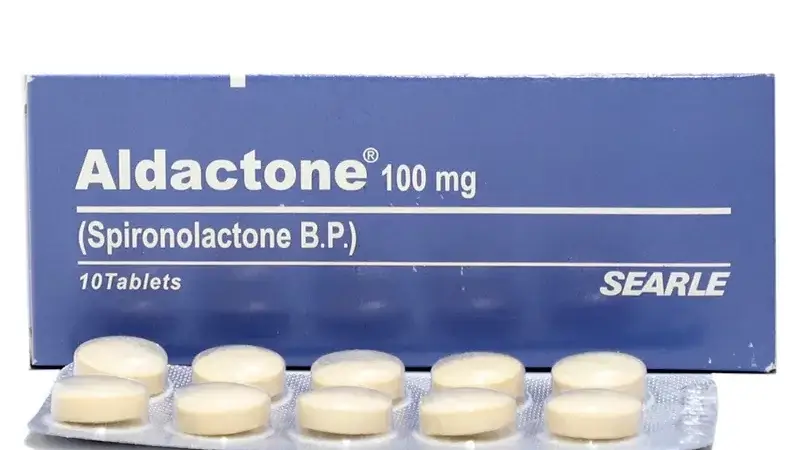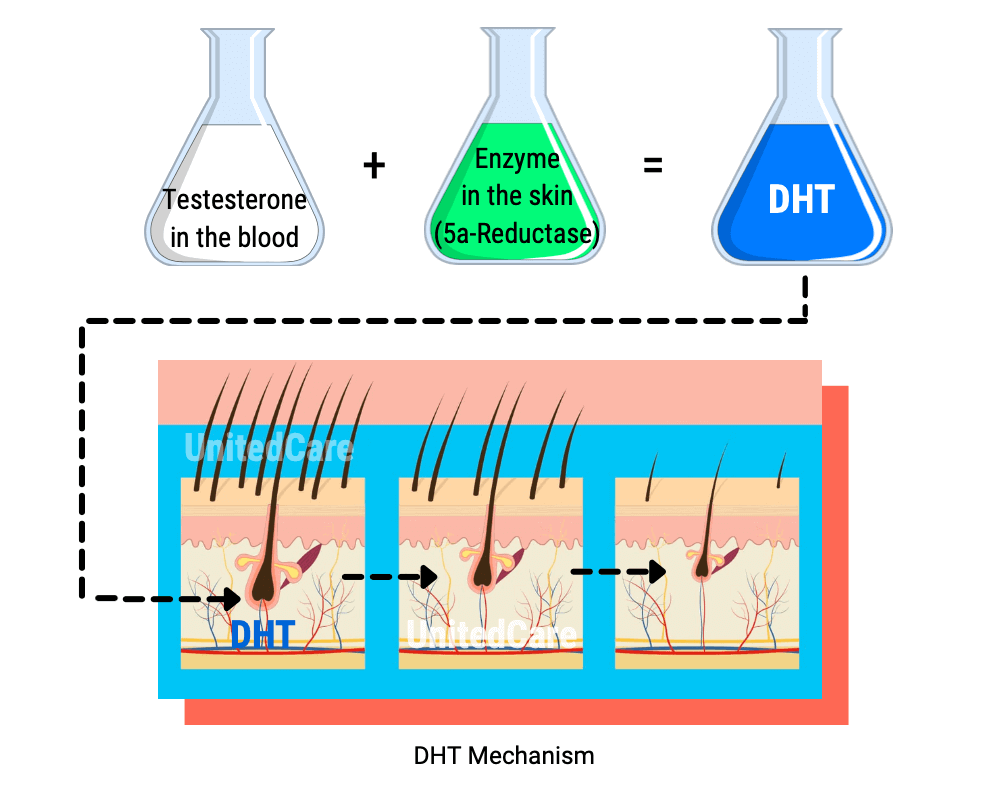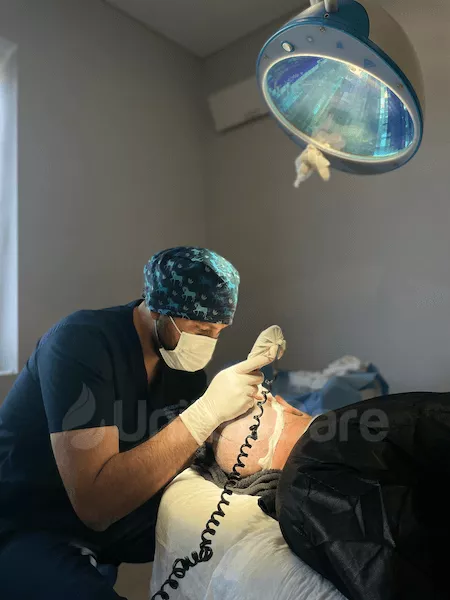According to global hair loss statistics of 2024, by the age of 50, 50% of men experience balding, which means half of the entire male population.
However, every year, the field of dermatology produces a new type of technology, a discovery to fight and help reduce these numbers even further.
And one of the newest medications we have for battling male pattern baldness (MPB) is Spironolactone.
As this new medication holds great potential, we shouldn’t waste any time getting into details.
So, in today’s article, I will explain what Spironolactone is, how it works, how effective it is, and what its side effects are:
Table of Contents
First, let’s get the obvious question out of the way:
What Is Spironolactone?

Spironolactone, usually under the brand name Aldactone, is a medication that can help many conditions connected to hair loss or not. Its FDA-approved primary purpose, though, is to treat fluid retention and illnesses such as high blood pressure or heart failure.
However, in the last couple of years, researchers have discovered that it holds a potential for battling androgenetic alopecia (AGA).
That is because Spironolactone directly works by regulating excessive hormones such as DHT.
To understand it better, we have to look at its working mechanism:
How Does Spironolactone Work?
Pattern baldness, as we know it today, is experienced due to the creation of a hormone called dihydrotestosterone (DHT). Due to this hormone, your hair gets thinner and falls out over time.

When we add Spironolactone into this process, its primary process of suppressing androgen hormones affects dihydrotestosterone as well. As a result, the medication helps boost your hair regrowth.
💡 Just remember that, like most hair loss medications, Spironolactone, too, is NOT a one-time solution. In other words, you’ll have to keep using it for about 6 months at least to see and maintain its benefits.
These all sound great, but to know if they are genuinely effective, let’s take a look at research:
The Efficacy of Spironolactone: What Do Studies Say?
Today, Spironolactone’s FDA approval exists only for its initial purpose. However, there are several different forms of treatment for pattern hair loss, topical or oral, ranging from 25 mg to 200 mg.
With such a high range of possibilities, it is no wonder that various studies have shown up in recent years about its benefits towards hair loss:
A 4-month study with 60 patients made in comparison to Finasteride
🟢 In late 2023, a large group of doctors conducted a blinded randomized clinical study on 60 patients with pattern baldness to test the efficacy of Spironolactone in treating hair loss.
🟢 The patients were divided into two groups. One group received Spironolactone 100 mg/day and the other Finasteride 5 mg/day. Also, a 2% Minoxidil solution was included in both groups.
🟢 At the end of the study, results were evaluated in terms of patient satisfaction and statistical changes based on The Hamilton-Norwood Scale.
🟢 Hair thickness and hair regrowth improved in both groups without any significant difference between each other statistically. However, patient satisfaction was significantly better in the Spironolactone group regarding hair density.
🟢 Ultimately, researchers found Spironolactone to be a suitable alternative treatment to Finasteride, if not even a more effective one.
As the medication has countless other similar studies, we decided to include data collection research instead:
A data revaluation research surrounding 784 different studies
🔵 In early 2023, a group of dermatologists conducted one of the biggest collective study revaluation examples about hair loss, and it was centered around systematically reviewing Spironolactone.
🔵 Searching the entire database up until 2022, a total of 784 studies was found, and with the chosen criteria, 7 articles comprised of 618 AGA patients were selected.
🔵 Patients received either oral Spironolactone doses ranging from 25 mg to 200 mg daily (mostly between 80 mg and 110 mg) or topical Spironolactone gels of 1% to 5% solutions twice daily.
🔵 Both options of Spironolactone showed high effectiveness for treating AGA. However, topical use had significantly fewer side effects. Also, it held better results when combined with other therapies, such as Minoxidil.
Ultimately, as these wide ranges of studies show, Spironolactone shows great results, even in comparison to prominent and established hair loss medications. 💡
However, like all effective medications, you should also take the side effects into consideration:
What Are the Side Effects of Spironolactone?

Spironolactone is relatively safe, but, just like all medications, health problems can occur if the medication is not used properly.
Alternatively, there is always a chance of experiencing side effects, no matter how uncommon they are.
Before knowing what to do to avoid them or how to react in the case that they appear, first, you should know what to look for, so here are all the potential side effects of Spironolactone:
🔴 Hyperkalemia (High Potassium Level)
🔴 Low Blood Pressure
🔴 Nausea
🔴 Diarrhea
🔴 Headache
🔴 Dizziness
🔴 Weight Gain
🔴 Depression
🔴 Low Sex Drive
Now that you know what the side effects include, let’s talk about what you should do to avoid them or react to them.
1️⃣ First, to avoid experiencing these symptoms in the first place, follow every bit of your doctor’s advice thoroughly when it comes to how you should use Spironolactone. That includes how much you should take and how often.
2️⃣ Secondly, inform your doctor about your medical conditions in-depth. Similarly, if you are going to take any other medication along with Spironolactone, tell your doctor about it first.
3️⃣ Last, but perhaps most important thing is that if any of the side effects mentioned above occur, call your doctor immediately.
Remember, clear communication with your doctor is always the key to safety.
To finish it up, now that you have the whole picture, there is only one question left to ask:
Should You Use Spironolactone?
To give my medical advice, as a dermatologist who has worked in thousands of cases over the years, I can say that Spironolactone does show great potential, but is still relatively new and needs more time to prove its efficiency and safety for treating hair loss.
That being said, if you have already tried other options but didn’t get a satisfying result, or they are simply not eligible for you, you could consider Spironolactone ONLY with your consulting doctor’s approval.
👉 However, regardless of how much your hair loss has progressed or whichever methods you have tried, I can guarantee that with the right clinic’s help, there is always a better, suitable option.
It all comes down to getting the right help:
Get the Treatment That Is Right for You With UnitedCare

👉 At UnitedCare, we accept only 1 patient a day regardless of the chosen method.
Our budget-friendly process begins with a free one-on-one consultation with our expert dermatosurgeons to determine your suitability.
💊 Our holistic approach provides advanced technologies and bio-enhancements to ensure you do not need another surgery.
We use intracellular solutions (a.k.a bio-enhancements), helping cells stay alive for days outside the body. These solutions increase graft survival rates significantly. 💉
Most importantly, our care assistant/patient manager is in contact with our patients even before and after the surgery, ensuring that your surgery results become permanent. 🍀
Affordable costs, a holistic approach, and experienced dermatologists on-site are here to provide you with the right solution.
Want to learn if you are suitable for a hair transplant surgery? Get a FREE consultation:
Combine Spironolactone with a hair transplant to get the best results.
Consult with a Dermatosurgeon now to learn more.
Frequently Asked Questions (FAQs)
Can Spironolactone help with hair loss?
Despite being relatively new compared to its alternatives, studies suggest that using Spironolactone continuously over a long period can help fight hair loss and promote hair regrowth. It should be noted here that Spironolactone is not a one-time solution cure that will fix your baldness overnight. Instead, to see and maintain its benefits, you will have to keep using it for at least 6 months. The good side is that the uncommon side effects work the same way. So, if you experience any, you can simply stop using the medication to get rid of them.
Is Spironolactone better than Finasteride?
It depends on the dosage you take. Various studies suggest that both medications have a similarly high rate of effectiveness. However, in much higher doses, especially when combined with other treatments such as Minoxidil, Spironolactone tends to surpass Finasteride. Still, it is too early to say that it is entirely a better option.

